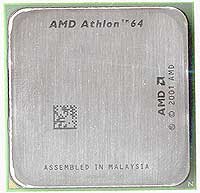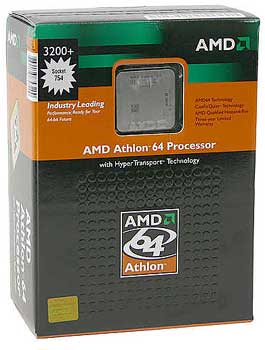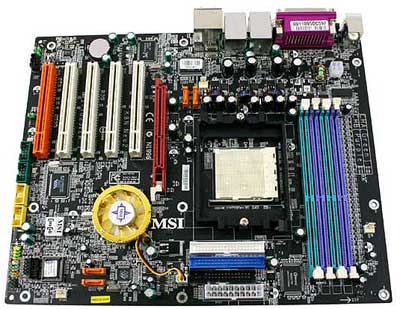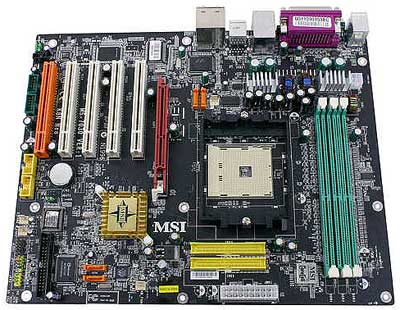Buyer's Guide - Mid-Range, October 2004
by Jarred Walton on October 21, 2004 11:00 AM EST- Posted in
- Guides
AMD CPU and Motherboard Recommendations
As we mentioned before, AMD has a decent performance lead in software development applications. Those of you who code for a living, not to mention users who like to use Linux, will probably want to go with an Athlon 64. These processors tend to compile code significantly faster than Intel processors, which is a common task in Linux use. Anyone who has tried to debug code knows how much shorter compile times help out. At times, you might be tweaking one or two lines of code, followed by a recompile and test of the changes; one small change can sometimes require several minutes of compiling and linking!Having settled on AMD, we are still greeted with a couple choices. Socket A is no longer a recommended option, due to its lack of performance as well as the looming end of the platform. Socket 754 and 939, however, are both reasonable choices. The difference here is that socket 754 tends to be cheaper for the same amount of performance, while socket 939 is more likely to have future processor upgrades available. Socket 939 boards should also start shipping with PCI Express support in the next month or two, which is something to consider. You can read more about this in our preview of NVIDIA's upcoming Nforce4 chipset. If those chipsets interest you, waiting another month or so might be wise. If you're looking to buy right now, you can choose the great price/performance of socket 754 with its limited CPU upgrades, or you can go with socket 939 with a slightly higher cost, but with the capability to upgrade to at least the FX-55/4000+ CPUs in the future.

AMD CPU Recommendation: AMD Athlon 64 3200+ 512K 2.0 GHz 90 nm (939)
Price: $215 Shipped (OEM)
Without spending a lot of money on a processor, the only reasonably priced chips for socket 939 are the new 90 nm Athlon 64 chips, a.k.a. Winchester. We published our initial look at these processors just last week, and they finally bring socket 939 to the mainstream price segment. Overclocking seems to work quite well on these chips, for those who are interested in that sort of thing. One minor problem with these new chips is that they are currently only available in OEM form, so you will need to purchase a separate heatsink and fan (HSF). We generally prefer Retail boxed processors as they include a certified HSF and do not cost much more than their OEM counterparts, and they also include a manufacturer 3-year warranty. That said, it has been quite a while since the last time we experienced a CPU failure. Those looking for more performance on a socket 939 platform can turn toward the 3500+, 3800+, and even the FX-53/4000+ and FX-55, but most of those are priced for the high-end segment. You might also be able to find a 3000+ 90 nm part for under $200, although they appear to be scarce right now and it might be another month before availability becomes widespread.

CPU Heatsink and Fan Recommendation: Spire KestrelKing III
Price: $20 Shipped
The HSF that we chose to go with the socket 939 CPU is the Spire KestrelKing III, but just about any socket 939 compatible HSF will do the trick. If you read our article on the new 90 nm Athlon 64 processors, you'll recall that they do not appear to generate a whole lot of heat. You could spend $30 or more on a high-end HSF, but for typical use, it isn't necessary.

AMD CPU Alternative: AMD Athlon 64 3200+ 512K 2.2 GHz (754)
Price: $200 Shipped (Retail)
You'll notice that the prices for AMD processors all dropped recently with the release of the FX-55 and 4000+ CPUs. This is welcome news to anyone who is in the market for a new system, and it allows us to increase the performance of our system relative to our last Mid-Range Guide without increasing the cost. $200 tends to be the sweet spot for processors and we see that here with the Athlon 64 3200+. At 2.2 GHz, it's 10% faster than the A64 3000+, and although it does cost about 20% more, we feel that this is acceptable for a Mid-Range computer. The 3400+ is also an option for additional performance and at 2.4 GHz, it is only slightly slower than the 3700+ and 3800+ at roughly half the cost. Our past tests have shown that the additional 512K of L2 cache does not usually boost performance of the Athlon 64 processors as much as an additional 200 MHz of clock speed will, so we recommend the Newcastle cores over the Clawhammer variants.
If you are interested in spending less for slightly slower performance, the Athlon 64 2800+ is now available for $140. The Sempron 3100+ will also work in socket 754, but it is difficult to recommend in this price segment as it lacks 64-bit support and has half as much L2 cache as the 2800+ while it only costs $17 less. In the future, though, Sempron may be the only option for socket 754 beyond the A64 3700+, as AMD is pushing the socket as its value platform with socket 939 being the performance choice. You can read more about this is our recent AMD Roadmap update. This is why we leave it as an alternative suggestion. If the $1250 price point is a bit too high for your budget, socket 754 is a great way to cut costs without cutting performance.

Socket 939 Motherboard: MSI K8N Neo2 Platinum
Price: $131 Shipped
The selection for socket 939 motherboards is relatively limited. At present, there are only three or four boards available at retail that use the nForce3 chipset, and there are another five or six boards that use the K8T800 Pro chipset. Perhaps it is simply a case of companies waiting for the PCI Express chipsets to become available, but whatever it is, the selection is not very large. Prices range from about $110 for the cheapest K8T800 Pro based boards up to $130 or so for the MSI board that we selected, and then there is an "everything plus the kitchen sink" Gigabyte board for around $200. We continue to recommend the MSI K8N Neo2 Platinum for its price, performance, and features. It does have one flaw worth pointing out, though: the heatsink on the NF3 chipset is very close to the AGP slot and can make the installation and removal of large graphics cards, like the 6800 Ultra, difficult. If that's a deal-breaker for you, you might want to check out the EPoX EP-9NDA3+.
For those who prefer something other than an NVIDIA chipset, we feel that the Soltek SL-K8TPro-939 and the MSI K8T Neo2-FIR are similarly equipped alternatives that are worth a look. Abit and ASUS also have boards that are worth considering, as they both cater heavily to the performance/enthusiast market.
There really aren't any truly inexpensive alternatives for socket 939 yet, and almost all of the boards come equipped with 8-channel audio, GbE, and Firewire support. If you don't need those features, you still have to pay for them. You also get 4 DIMM sockets on all the boards, and they should all work properly at PC3200. This is a nice change from socket 754. PCI Express is right around the corner on socket 939, but the performance is generally about the same as equivalent AGP. There are several graphics cards at attractive prices that are only for PCIe right now, so after you read our graphics recommendations, you might decide that it's worth waiting for. For non-gaming use, however, it probably won't matter much.

Socket 754 Motherboard: MSI K8N Neo Platinum
Price: $122 Shipped
The choice of motherboard, particularly for socket 754, is rather difficult. We have chosen the MSI K8N Neo Platinum based on price and features. It includes full support for the nForce3 250Gb chipset, which means it has gigabit Ethernet with a hardware firewall. It also includes support for up to 3 Firewire ports, 4 SATA devices, and 8 channel audio. Similarly equipped boards such as the DFI LANPARTY UT nF3, the ASUS K8N-E Deluxe, and the Chaintech ZNF-250 are also possibilities that all cost about the same as the MSI board. Performance may be slightly better with some of these boards, but we have not had any complaints with the MSI board and continue to recommend it. The ZNF-250 has some extra goodies in the package like a flash memory reader that might make it worth the additional cost.
Those interested in a better price can take a look at boards like the Chaintech VNF-250 and EPoX EP-8KDA3J, as well as a large number of other boards. We still prefer the nForce3 250 chipset over the VIA K8T800 Pro, mainly on the basis of features, but to those looking for a VIA alternative, the only readily available motherboard using the newer chipset is the Abit KV8 Pro. Unfortunately, it costs more and compares rather poorly with the Chaintech board. The differences between the K8T800 and the "Pro" are relatively minor, so you could also opt for an older board like the Asus K8V. One thing to look out for is that many of the older socket 754 boards have problems running two or more DIMMs at PC3200 speed, which is why we recommend boards that use the newer chipsets. The other side of the story is that there are also many cheaper socket 754 boards that only come with two DIMM slots, which obviously gets around the difficulty of running three DIMMs by simply avoiding that option.
The bottom line is that the battle for price/performance still belongs to socket 754, but not by a lot. It's a tough call, but we give the edge to the socket 939 configuration as it has a better outlook in terms of longevity. By the time that you're ready to upgrade to a faster CPU, however, you might need to upgrade to a newer motherboard anyway.










54 Comments
View All Comments
filterxg - Tuesday, November 2, 2004 - link
I think this type of article is great. I may be in the market in the next 2 months and am reading up. Considering waiting until 64-bit XP comes out. But my Athlon 850 is on its last legs, and no news from Microsoft is bad news for me.JarredWalton - Tuesday, November 2, 2004 - link
I know what you mean on the tech support side. Problem is, even if I told my mom or whomever to buy a Dell, I *know* that I would end up doing the support. My mom wouldn't even know what the hell to say to a Dell support person. I laugh just thinking about it. (Yeah, I built her a PC so that she can get email. Now I get questions asking me why Juno doesn't work and sometimes crashes. Ugh.)Also, for those that were wondering about the choice of DVD+R, you can now see where I got the information for the NEC 3500A:
http://www.anandtech.com/storage/showdoc.aspx?i=22...
I had the Pioneer in originally, and Kris let me know in advance that the NEC was slightly preferred. Both are good drives, though, so it's not a decisive win in all areas. (Not like anyone is going to see the comment other than HH, but oh well.)
hh - Monday, November 1, 2004 - link
> HH - Hobbyist DIY vs. "regular" DIY? I don't> even know that I gave it that much thought.
It is merely something to consider.
>I actually find it fun to build new PCs.
Glad you enjoy it. My interest is to get on with it to using the PC, not the screwdriver-turning.
I'll still DIY if the cost savings potential is big enough to motivate...the problem is that that bar gets raised progressively higher as I have less free time. If the OEM price premium is less than 10-20%, I'll pay it in a heartbeat.
(Of course, this assumes ojbectively equal products, so we're back to system benchmarks questions).
>Having done plenty of support at companies that
>use Dell and other large OEM PCs, I wouldn't
>recommend them to an individual.
I know and undertand the frustration here. But we've already agreed that DIY's are not for the non-savvy PC user; my mother-in-law is a prime example...she's on dialup but can't figure out how to have the antivirus app do its updates.
>For businesses that can pay the extra $$$ for
>the support contracts, sure, go for it, but
>individual users? I just don't see OEMs as
>providing enough *quality* support to warrant
>my recommendation. YMMV.
The only thing worse than the OEM's are the "Armchair Expert" helpers. Based on their "expert" advice, Mom-in-Law just paid for a hard drive replacement to fix a spyware infection problem.
The frustrating part is that we both know that this failure mode is going to occur again. I'm tempted to convert her over to Apple to stop it, but that would cause a Family fight, especially since Sis-in-law doesn't want to have to admit that the spyware infections are being caused by her kids surfing on their Grandma's PC...
Pass me that bottle of Scotch, would you? :-)
-hh
JarredWalton - Friday, October 29, 2004 - link
HH - Hobbyist DIY vs. "regular" DIY? I don't even know that I gave it that much thought. I know that I personally would never go out and buy an OEM desktop system, but I'm probably far from your typical PC user. I actually find it fun to build new PCs. Having done plenty of support at companies that use Dell and other large OEM PCs, I wouldn't recommend them to an individual. For businesses that can pay the extra $$$ for the support contracts, sure, go for it, but individual users? I just don't see OEMs as providing enough *quality* support to warrant my recommendation. YMMV.BBurk: To get a "quiet" setup, the Antec 3700BQE is a great start. If you really want quiet, add in a Zalman CNPS7000A/B heatsink and fan, as it is again nearly silent. You could replace the PSU with one of the fanless Thermaltake or Antec models - only 350W, but that should suffice, I think. Both Seagate and Samsung make near-silent hard drives, although the latest WD, Maxtor and Hitachi really aren't any worse, I don't think. I just say avoid WD Caviar with non-FDB bearings. Also, if possible, look for a motherboard that doen't use a fan on the northbridge, and if you don't need the graphics power, get a graphics card that uses only a heatsink as well. That would make a system virtually silent, at the cost of some performance (especially on the graphics card).
hh - Thursday, October 28, 2004 - link
#48/JarredWalton>Actually, HH, shipping *was* included...
Sorry, I missed that detail.
> What you don't get are several upgrades that
> most hobbyists would like.
On the contrary. What you apparently missed is that I had very explictly and specifically differentiated DIY'er types upfront and was not talking about the classical hobbiest.
Instead, I was talking about DIY'ers who do it because of the cost savings, and who generally doesn't care a lick about possible future upgrades: they care about are today vs. OEM and usually not much else.
> The case/PSU and motherboard are proprietary
> designs, so if one of those items fails after
> the warranty expires...
A valid if generally negligible risk, due to the classical "Bathtub" shaped reliability curve for electronics. Yes, some OEM's have real garbage, but let's also not overhype this objective risk.
> I realize not everyone can build their own PC,
> but most Anandtech readers are more than
> capable of doing so.
Anotehr truism, but simply not a particularly relevant point to my arguement.
> That's who we target with our Guides.
Are you targeting hobbiest DIY'ers, or all DIY'ers?
I'd say you're really only doing the former.
FWIW, it appears to me that you've essentially assumed that just because one can DIY that one will always DIY. That can be a bad assumption. IMO, this is possibly why some posters asked about benchmark tests, and why I suggested also including OEM systems in such a comparison too, as I was following the classical business case of a "Make or Buy" decision.
Please understand that I'm not Anti-DIY or Pro-OEM: I'm agnostic. Our differences are likely because my criteria for when my time investment in a DIY is justified is different than what yours is, and the net result is that I don't automatically reject all OEM's without even a glance.
-hh
BBurk - Thursday, October 28, 2004 - link
What reccomendations of changes would you make for a very quiet/silent system? thanksJarredWalton - Monday, October 25, 2004 - link
Actually, HH, shipping *was* included (and added about $50 to the total). That's shipping to the continental US, of course, so if you live somewhere else it would be different.I put together a Gateway system with a P4 530 and X300SE, 1GB of RAM, 19" monitor, and 2.1 speakers. Including OS and MS Works (which OEM costs $71) we get a total price - shipped with 1 year warranty - of $1364. Adding Works and XP Home to the P4 system in this guide costs $1385. For all intents and purposes, then, it's a tie in price.
If you only want a basic system, then, Gateway would be fine. What you don't get are several upgrades that most hobbyists would like. Better graphics, better speakers, better monitor, better case, better motherboard, etc. Gateway will give decent parts in each category, but the emphasis will be on cutting costs.
The case/PSU and motherboard are proprietary designs, so if one of those items fails after the warranty expires, your only choice is to either buy an expensive replacement from Gateway, or else buy a new case, PSU, and motherboard. Proprietary designs are a really bad thing, people. I would spend more money at a local computer shop for a "generic" PC rather than buy a Dell or Gateway or other OEM.
My rate for building a PC and installing the OS is $100, which is pretty typical. That amounts to about $25 an hour. If I wanted to cut $100 out of the system cost by going with cheaper components in every area, I could certainly do so, but then reliability is compromised.
I realize not everyone can build their own PC, but most Anandtech readers are more than capable of doing so. That's who we target with our Guides. Some people think that OEM systems are more reliable due to their warranties and such, but that's not the case in my experience. I would say 90% of the PCs people ask me to help fix are OEM designs. Maybe that's because the non-OEM systems are built by people that can manage on their own, or maybe it's because the parts don't fail as often. I know what I think, but you're entitled to your opinion.
The only caveat is that I won't build a PC for someone that knows nothing about computers. I can't provide 24/7 tech support. OEMs do give you that, although the quality of the provided support is questionable. :)
hh - Monday, October 25, 2004 - link
#40/Jarred Walton> #34 brings up an interesting argument.
Thanks for the compliment.
> If you actually went out and bought the same hardware that goes into [an OEM], the price would be a lot lower than what is listed here...The price of OEM systems appears attractive, but in the end you get what you pay for.
I agree, but offer an alternative perspective. In my view, the're two very common shortcomings in the DIY-vs-OEM arguements.
The first is trying to decide/define equivalency. Its too easy to get lost down in the weeds (specific components, etc) and essentially ignore system performance.
For example, I can put together a "kinda looks equivalent" Gateway for $1319 or buy the one DIY and add the OS for $1304 - - - a whopping $15 cost savings for skipping the OEM's assembly, warranty and copy of MS-Works software. The catch here is that the OEM's probably doesn't benchmark at 100% of the DIY, but how close is good enough? 99%? 95%? 90%? 80%?
There is no simple, cut and dry answer to this question: its a personal opinion based on what significance rankings and (cash) value you want to put on the differences between the two contenders.
The second shortcoming is in how we choose to count our costs. For example, this article ignored shipping costs, probably because we all know that they'll be different for all of us.
But in the similar fashion, we also commonly ignore how much our labor is worth when we do a DIY assembly. And we can argue that we do this because we'll all put different values on how much our time is worth.
But the real bottom line is that our free time is never worth nothing, despite the fact that we invariably choose to ignore it in the cost of doing a DIY PC build, which results in faulty accounting for how much we're really saving.
FWIW, if anyone really wants to claim that their free time really is worth zero dollars, I have a lot of chores for you to come over and do at my house...heck, I'll even pay a whole $5/hour :-) Funny thing is that I don't ever get any takers at this hourly rate...it seems that everyone knows that their time is worth more than this, and yet never includes it in their DIY budget. Hmmm. :-)
-hh
TrogdorJW - Monday, October 25, 2004 - link
#45: XP Home will actually work with up to two CPUs, I believe. Someone can correct me if I'm wrong. Anyway, I *think* that MS actually recognizes HyperThreading at a low level and only counts it as one CPU even though it show up as two. Anyone out there able to confirm that for sure?slashbinslashbash - Sunday, October 24, 2004 - link
2 things:1) XP Home still isn't SMP-enabled, right? Therefore shouldn't the recommendation be XP Pro if you get an Intel (Hyperthreaded) setup?
2) Gamers (and others griping about the 9600Pro in this guide) should look to the Overclocking Buyer's Guide released about a month ago. That guide included a 6800GT in a system costing $1113 (without monitor/keyboard/mouse/etc). Downgrading to a 9800Pro would leave the system comparably priced to the systems in this Midrange guide. Also, the case/PSU in that guide was pretty expensive as well.